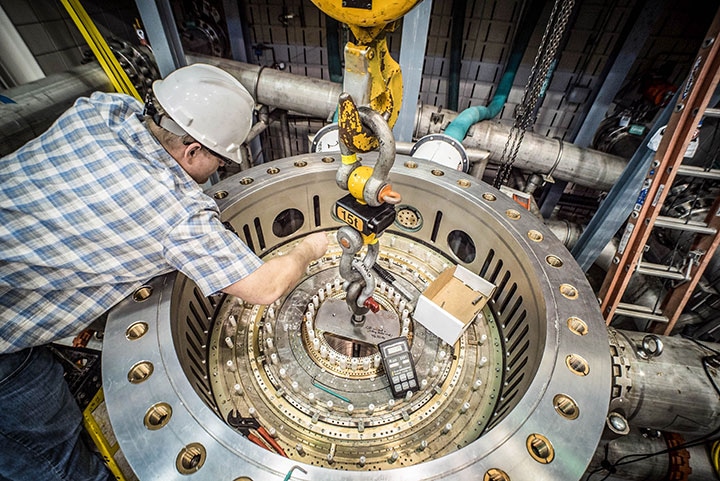Aug 24 2017
Engineers at the Florida State University-headquartered National MagLab were busy with an eclipse of a different sort while the rest of the country watched the much awaited solar eclipse on August 21st. Not to be surpassed by celestial happenings, they set a new world record that erased the earlier one by roughly 8% — a sizable jump in magnet technology terms.
 Magnet designer Jack Toth works on installing the coils in the housing. (Photo by Stephen Bilenky.)
Magnet designer Jack Toth works on installing the coils in the housing. (Photo by Stephen Bilenky.)
The new instrument accomplished 41.4 teslas (a unit of magnetic field strength) at 1:10 p.m. on August 21st, the conclusion of two and a half passionate years of design and development. In so doing, the lab regained the record for the strongest resistive magnet in the world, which it had retained for 19 years up until 2014. The feat takes the lab’s present tally of world records to 16.
The work has been referred to as Project 11 by in-house members, a reference to the 1984 mockumentary “This is Spinal Tap” about a fictional rock band. In a particular scene, a guitarist exhibits his unique amplifier, which has a top setting of 11 — one notch more than the regular 10.
That additional oomph allowed the lab’s new magnet, powered by 32 megawatts of direct current (DC) power, to jump over the former record-holders, a 38.5-tesla resistive magnet in Hefei, China, and a 37.5-tesla resistive magnet in Nijmegen, the Netherlands.
More significantly, the new instrument answers the need of Physicists for stronger resistive magnets — also referred to as DC magnets — so as to observe new phenomena in the materials they are examining.
Resistive magnets are the bread and butter of our DC Field Facility, and the demand of scientists sometimes exceeds supply. With the Project 11 magnet, we asked our engineers to ‘turn it up a notch’ and see what they could accomplish. This new brute delivers and will enable scientists to make discoveries that lead to better materials and technologies and deepen our understanding of how our world works.
Greg Boebinger, Director, MagLab
The MagLab’s magnet fleet comprises of many kinds of instruments: resistive magnets, made of silver and copper, like the Project 11 magnet; superconducting magnets, which require expensive materials and hybrid magnets, a combination of both designs. The lab’s 45-tesla magnet, the world’s most robust continuous-field magnet, is a hybrid design and one of the lab’s most preferred tools.
The new 41.4-tesla magnet is easier for Researchers to use than a hybrid and gives them more flexibility to regulate the field and polarity while performing experiments. The new system will be accessible to visiting researchers in the months ahead, joining a fleet that features a pair of 35-tesla instruments that, until this week, had been the strongest resistive magnets in the lab.
Although the lab’s latest magnet functions on the same principles as all resistive magnets, it is no ordinary machine. Lab Engineers, relying on years of experience designing and developing the lab’s other innovative magnets, incorporated enhancements to maximize the electrical current density that helped catapult them to achieve the new world record. At the same time, they limited costs by repurposing parts from old magnets.
This larger magnet allows us to use 50 percent more coils. That enabled power to be distributed more efficiently within the magnet and reach a new record with the same materials.
Jack Toth, Veteran Magnet Designer
Three years ago, other labs accomplished higher fields by developing magnets four to five times larger than those at the MagLab, said Mark Bird, Director of the Lab’s Magnet Science and Technology division. “This new magnet levels the playing field in size,” he said, “but our superior technology allows us to reach ‘11.’”
Although MagLab staffers are pleased to regain their long-held record, the deeper motivation is to facilitate stimulating new science.
It’s about providing the scientific community access to high fields. That’s why we’re here.
Tim Murphy, Director of the DC Field Facility, which houses the new magnet